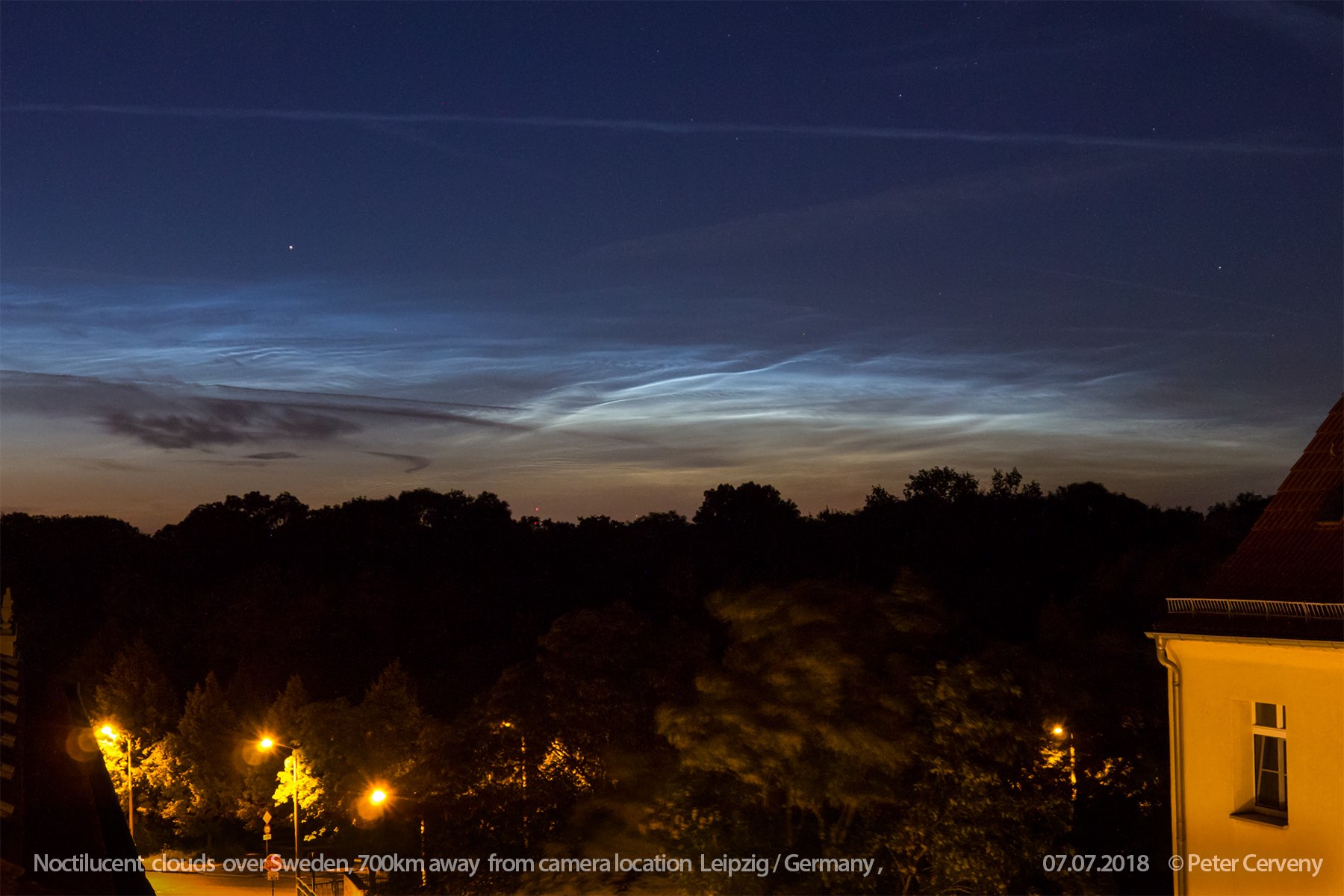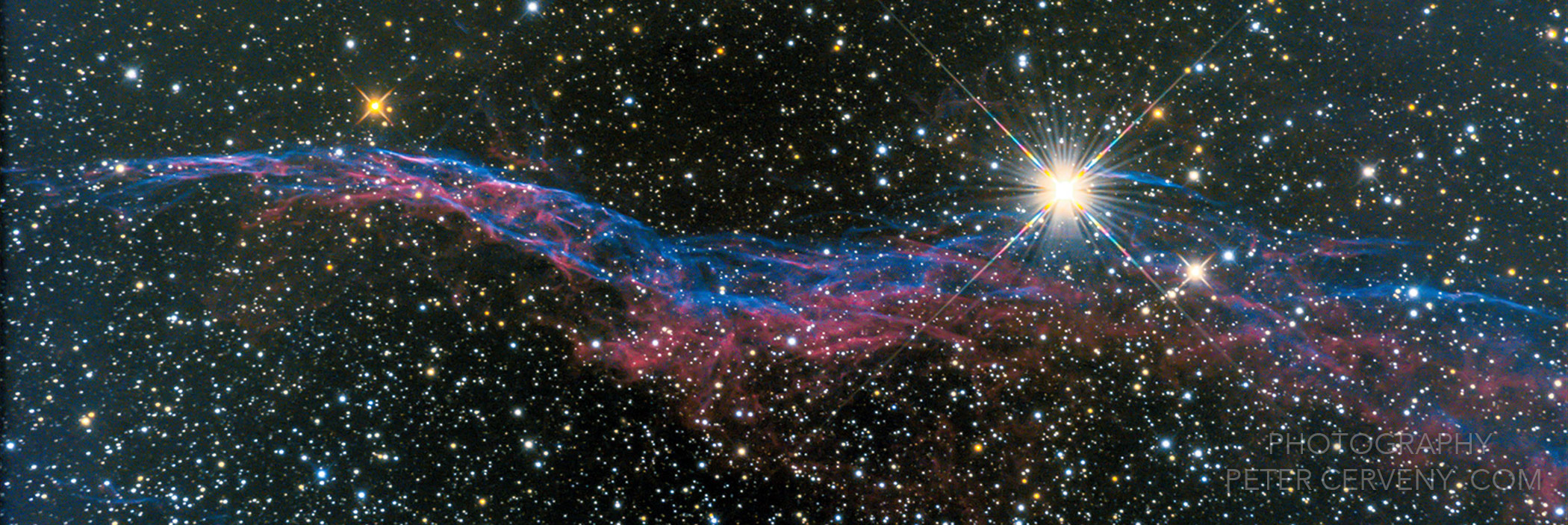
Noctilucent clouds, or night shining clouds, are tenuous cloud-like phenomena in the upper atmosphere of Earth. They consist of ice crystals and are only visible during astronomical twilight. Noctilucent roughly means "night shining" in Latin. They are most often observed during the summer months from latitudes between 50° and 70° north and south of the Equator. They are visible only during local summer months and when the Sun is below the observer's horizon, but while the clouds are still in sunlight. Recent studies suggests that increased atmospheric methane emissions produce additional water vapor once the methane molecules reach the mesosphere - creating, or reinforcing existing noctilucent clouds.
They are the highest clouds in Earth's atmosphere, located in the mesosphere at altitudes of around 76 to 85 km. They are too faint to be seen in daylight, and are visible only when illuminated by sunlight from below the horizon while the lower layers of the atmosphere are in Earth's shadow.
Night clouds or noctilucent clouds are composed of tiny crystals of water ice up to 100 nm in diameter and exist at a height of about 76 to 85 km, higher than any other clouds in Earth's atmosphere. Clouds in the Earth's lower atmosphere form when water collects on particles, but mesospheric clouds may form directly from water vapour in addition to forming on dust particles.
Data from the Aeronomy of Ice in the Mesosphere satellite suggests that noctilucent clouds require water vapour, dust, and very cold temperatures to form. The sources of both the dust and the water vapour in the upper atmosphere are not known with certainty. The dust is believed to come from micrometeors, although particulates from volcanoes and dust from the troposphere are also possibilities. The moisture could be lifted through gaps in the tropopause, as well as forming from the reaction of methane with hydroxyl radicals in the stratosphere.
The exhaust from Space Shuttles, in use between 1981 and 2011, which was almost entirely water vapour after the detachment of the Solid Rocket Booster at a height of about 46 km, was found to generate minuscule individual clouds. About half of the vapour was released into the thermosphere, usually at altitudes of 103 to 114 km.
The exhaust can be transported to the Arctic region in little over a day, although the exact mechanism of this very high-speed transport is unknown. As the water migrates northward, it falls from the thermosphere down into the colder mesosphere, which occupies the region of the atmosphere just below. Although this mechanism is the cause of individual noctilucent clouds, it is not thought to be a major contributor to the phenomenon as a whole.
As the mesosphere contains very little moisture, approximately one hundred millionth that of air from the Sahara, and is extremely thin, the ice crystals can form only at temperatures below about −120 °C. This means that noctilucent clouds form predominantly during summer when, counterintuitively, the mesosphere is coldest, therefore they can't be observed (even if they are present) inside the Polar circles because the Sun is never low enough under the horizon at this season at these latitudes. Noctilucent clouds form mostly near the polar regions, because the mesosphere is coldest there. Clouds in the southern hemisphere are about 1 km higher than those in the northern hemisphere.
Ultraviolet radiation from the Sun breaks water molecules apart, reducing the amount of water available to form noctilucent clouds. The radiation is known to vary cyclically with the solar cycle and satellites have been tracking the decrease in brightness of the clouds with the increase of ultraviolet radiation for the last two solar cycles. It has been found that changes in the clouds follow changes in the intensity of ultraviolet rays by about a year, but the reason for this long lag is not yet known.
Noctilucent clouds are known to exhibit high radar reflectivity, in a frequency range of 50 MHz to 1.3 GHz. This behaviour is not well understood but a possible explanation is that the ice grains become coated with a thin metal film composed of sodium and iron, which makes the cloud far more reflective to radar, although this explanation remains controversial. Sodium and iron atoms are stripped from incoming micrometeors and settle into a layer just above the altitude of noctilucent clouds, and measurements have shown that these elements are severely depleted when the clouds are present. Other experiments have demonstrated that, at the extremely cold temperatures of a noctilucent cloud, sodium vapour can rapidly be deposited onto an ice surface.
| Object | Noctilucent clouds |
|---|---|
| Position: | over south sweden |
| Altitude: | 76 to 85 km |
| Distance (average) | about 600-700km |
| Photo Datas | |
| Date | 07.07.2018, 20:25 UTC |
| Location | Leipzig/Germany |
| Telescope | Lumix f/4.6 25mm |
| Camera | Lumix G3 |
| Expose frames | ISO 800 |
| Total expose |
6 sec. |
| Remarks |
C 2018 Peter Cerveny
